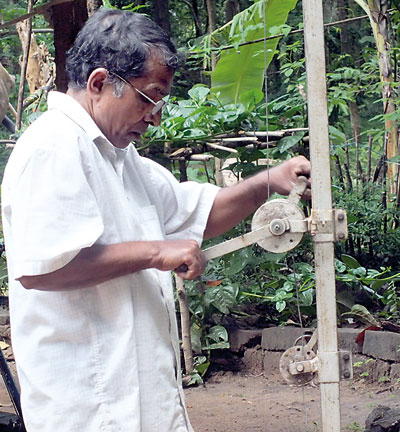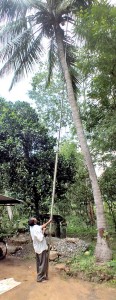Rural Sri Lankan entrepreneur develops adjustable coconut plucking pole
While Sri Lanka’s rural innovative technological talent is wide ranging compared to the talent pool in urban areas, there is need for a process of identifying and promoting them to start up businesses.

Winding wheels.
This is the very task that has been undertaken by the National Science Foundation (NSF), which operates under the purview of Ms Anusha Amarasinghe, its Director General.
To prove their attempts and in a bid to muster the virgin talent of the rural people, the NSF took the Business Times to discover a technological marvel.
Turning off from the Kurunegala – Dambulla road at Bakmeewewa it was an arduous and long journey to reach a remote village called Kumbukwewa, Negampaha, last week.
The house is in a backdrop of a large land where more cultivation of coconut, etc would attract an elephant attack. There H.M. Sugathadasa, who has invented a steel ‘Plucking Pole’, showed how with little innovation raw technology could be used to pluck coconut and other nuts on high trees. Mr Sugathadasa’s invention was chosen after he had responded to a notice published by the NSF.
The NSF, in a bid to facilitate innovative technology development and support for start up business once the innovation is developed, established two grant schemes. This enables the research outputs beyond laboratory scale by extending financial support. Mr. Sugathadasa is a born inventor. Once while working at the Kotmale Mahaweli project in 1982 inside the tunnel, a technical problem arose which even the foreign engineers were unable to resolve. Mr, Sugathadasa intervened and solved it and he was granted a salary increase during his probation period.
Now 63 years old, he has made so many inventions that industrialists and people come to him to get their technical issues solved. Sometime ago he got a mobile telephone and at that time there were no signals in this remote village. What did he do? He invented an adjustable pole which could pop up whenever he wanted to get signals for him to use the telephone.

Plucking the coconuts. Pix by Quintus Perera
At that point of time his invention was very useful for, some mobile telephone providers too purchased his adjustable pole. But with the advent of communication signal towers, his business dried up.
Sipping a cup of tea seated in the verandah of his house bordering the gravel road leading to the historical Buddha Statue – ‘Resvehera’, Mr. Sugathadasa explained how he had then developed the pole to be used to pluck coconut and nuts in high trees, which he initially used to capture signals.
He walked to the back of his residence and brought a long – about 20 ft by 2 inch – steel box bar fitted with cable winding wheels, etc. He started winding the wheels to which steel cables are attached and out popped a 60 ft long pole which he took to a coconut tree nearby and started plucking coconuts.
Inside the outer steel box bar, there are two more steel box bars smaller in dimension and with the wheels and cables the two smaller box bars comes out – about three box bars of 20 ft straightened to make a 60 ft long pole. He told the newspaper that with some assistance this instrument could be made lighter, using aluminum or hard fibre-glass and also longer to reach very high coconut or other trees. These improvements could also make the instrument mechanically operated.
As in many commercial crops like tea, rubber, cinnamon, etc the plucking, taping and peeling are generally done manually. In the case of coconut plucking too either people have to climb very high trees or use long bamboo poles to pluck coconut. In this case what Mr. Sugathadasa has invented would be ideal for coconut plucking, which is portable and flexible or adjustable when using.
In the case of NSF all what they do is to identify the technological inventions and examine whether they could be commercially viable and with some financial assistance to further improve the invention and then try to find investors to push them to the market. Now in the case of the ‘plucking pole’ the NSF has found that it is commercially viable but some improvements and adjustments have to be made and they are now striving to seek people to put the finishing touch and get some investors to merge with the inventor.
In this regard NSF has requested any interested investor to contact them on telephone 011 2676766 or email – td@nsf.ac.lk
In the coming weeks the Business Times will profile more innovative products identified by the NSF that would improve the life of the people and their livelihoods.
(QP)


